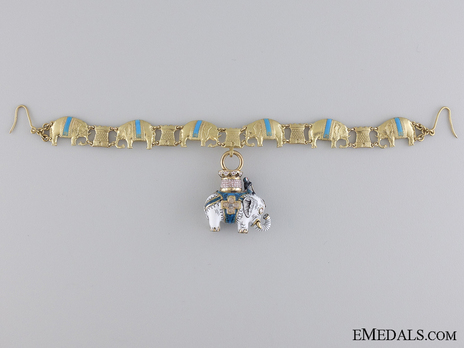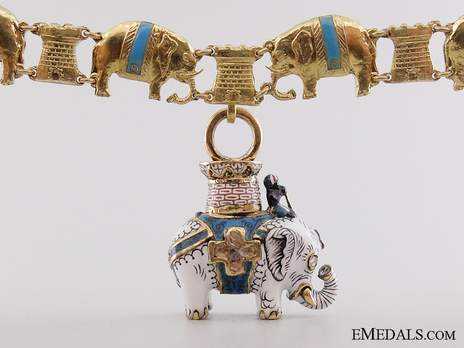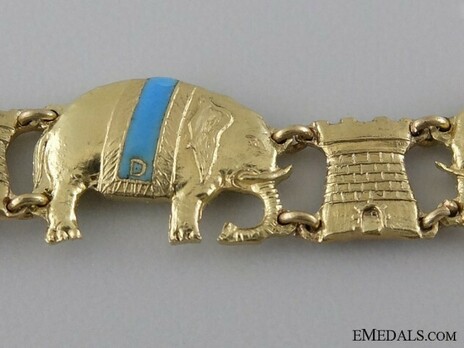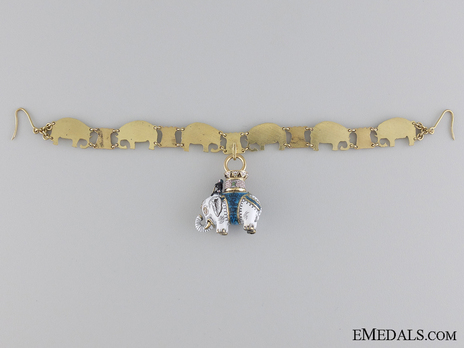Order of the Elephant, Miniature Collar
CATEGORY: Miniature
SKU: 01.DNK.0101.101.01.M.000
Estimated market value:




Estimated market value:
Established by King Christian I, this Order was originally named “the Order of Gods Mother” or “the Fellowship of the Mother of God”, and was created in recognition of the Danish gentry. This Order has been known as one of the most noble and oldest Orders of Europe, and it is the highest ranked Order of Denmark. During the reformation of Denmark (1530-1536) the Order was discontinued until King Frederik II re-instituted it as a non-religious Order in 1580, wherein he renamed it “the Order of the Elephant”. Throughout the years, membership of this Order was limited to the Monarch, princes of the royal bloodline, Knights, and occasionally bestowed upon commoners, such as, Danes who have rendered particularly outstanding service to the throne or foreigners rendering services to the country. The Order became very exclusive from 1850, as it has been rarely conferred upon commoners. The Order insignia is returned to the throne upon death.
In 1958, during the reign of King Frederik IX, women were admitted to this Order. Previously, only Danish and foreign reigning Queens were eligible to receive this Order. Women who receive this Order have sashes that are not as wide as the men's sashes.
Under the reign of King Christian IV, the Order of the Elephant was not awarded. Instead he awarded the Order of the Mailed Fist.
Although there are no preserved insignia from the Catholic period of this Order, the original design was composed of elephants links to form a collar, very similarly to the present collar of the Order. Hung from the collar was a badge of the Virgin Mary holding baby Jesus, surrounded by a crescent moon and the rays of the sun. Beneath that, was a medallion with the crown of thorns and three nails. This design was meant to represent purity and chastity.
After the reformation, the elephant became the badge of the Order. Throughout the years many variations of the elephant design have been introduced. In order to distinguish time periods, the reverse of the elephant always features the monogram of the awarding monarch. There may also be differences in the enamel on the tower of the elephant and the detailing on the elephant's face.
The oldest existing insignia dates back to 1580 during the reign of King Frederik II and there are no preserved insignia from the time of King Frederik III’s reign.
During the reign of King Christian V, the “Baroque elephant” was a term used to distinguish the elephant used during his rule.
Many pieces of this Order are preserved in museums.
The elephant of the Order is either worn on a sash or a collar, but never both at the same time. The collar is exclusively worn by the royal family and Scandinavian heads of state, whereas, the sash is worn by commoners. The collar is ordinarily used only on three specific days of the year: in January on the royal family’s New Year’s reception, on the ruler's birthday, and in June to honour Valdemar the Victorious.
Consisting of gold and enamelled alternating elephants, with watchtowers in between, there are many design design variations of the collar. The collar conferred upon princes were often made in gold, others, often in silver gilt, and from the 1800’s, often made from bronze gilt. There have been very few chains produced in the 20th century since the collar is often passed down rather than recreated.
Some sources claim that the collar may not have been instituted until 1693.

Comments
Sign in to comment and reply.


Scroll Top